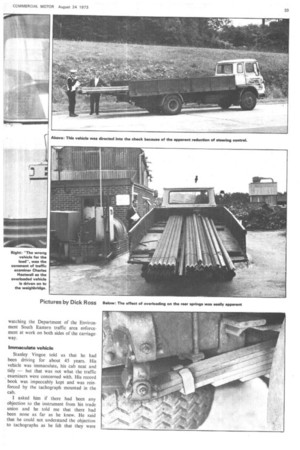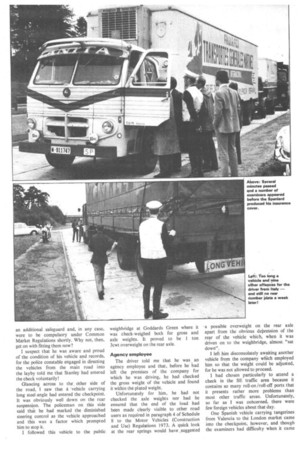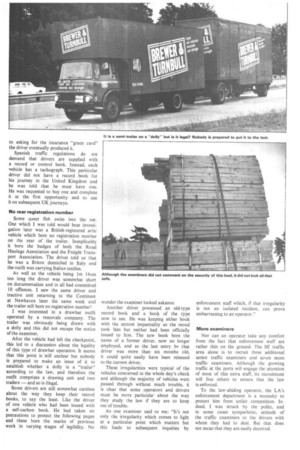SE area chief enforcement officer A. R. Brown discusses a
Page 34

Page 35

Page 36

Page 37

If you've noticed an error in this article please click here to report it so we can fix it.
tachograph chart with Stanley Vingoe while traffic examiner Ted Home is delighted to look at the impeccably kept record book.
Take care not to be a checkpoint 'Charlie'
Carelessness rather than deliberate evasion could be the reason why so many drivers have an uncomfortable time at DoE roadside checks. Paying attention to detail might save an operator a visit from the traffic examiners
by Johnny Johnson
"EVERY COMMERCIAL VEHICLE should be fitted with a tachograph for the protection it gives to the driver," said driver Stanley Vingoe from Bakers Transport (Southampton) Ltd, "and what's more, you chaps ought to do this sort of thing more often". The "sort of thing" that Stanley was referring to was a traffic examiners' roadside check at which he was an early arrival.
"Good for you, Stanley" I thought to myself, "this is going to confirm my
opinion". It all started with a conversation with my friendly neighbourhood traffic examiner. I had felt that the regulations about such things as hours and records had become almost second nature to operators by now. Moreover, I thought, the penalties involved in not complying with the law, entailing not only a probable conviction at a magistrates' court but also an appearance at a Licensing Authority's public inquiry, made evasion unprofitable.
See for yourself On the whole, I felt that most operators tried to operate within the law — and on putting this to my traffic examiner friend I was invited to go along and see for myself. That was why I found myself one cloudy summer morning at a layby on A/3 — the Brighton road — at Handcross watching the Department of the Environment South Eastern traffic area enforcement at work on both sides of the carriageway.
Immaculate vehicle Stanley Vingoe told us that he had been driving for about 45 years. His vehicle was immaculate, his cab neat and tidy — but that was not what the traffic examiners were concerned with. His record book was impeccably kept and was reinforced by the tachograph mounted in the cab.
I asked him if there had been any objection to the instrument from his trade union and he told me that there had been none as far as he knew. He said that he could not understand the objection to tachographs as he felt that they were an additional safeguard and, in any case, were to be compulsory under Common Market Regulations shortly. Why not, then, get on with fitting them now? I suspect that he was aware and proud of the condition of his vehicle and records, for the polibe constable engaged in directing the vehicles from the main road into the layby told Me that Stanley had entered the check voluntarily!
Glancing across to the, Other side of the road, I saw that a 'vehicle carrying long steel-angle had entered the checkpoint. It was obviously well down on the rear suspension. The policeman on this side said that he had marked the diminished steering control as the vehicle approached and this was a factor which prompted him to stop it.
I followed this vehicle to the public weighbridge at Goddards Green where it was check-weighed both for gross and axle weights. It proved to be 1 ton 3cwt overweight on the rear axle.
Agency employee
The driver told me that he was an agency employee and that, before he had left the premises of the company for which he was driving, he had checked the gross weight of the vehicle and found it within the plated weight. Unfortunately for him, he had not checked the axle weights nor had he ensured that the end of the load had been made clearly visible to other road users as required in paragraph 4 of Schedule 8 to the Motor Vehicles (Construction and Use) Regulations 1973. A quick look at the rear springs would have _suggested a possible overweight on the rear axle apart from the obvious deiveSsion of the rear of the vehiele which, when it was driven on to the weighbridge, almost_ "sat down".
I left .him disconsolately awaiting another vehicle from the company which employed him so that the weight could be adjusted, for he was not allowed to proceed.
I had chosen particularly to attend a check in the SE traffic area because it contains so many roll-on/roll-off ports that it presents rather more problems than most other traffic areas. Unfortunately, so far as I was concerned, there were few foreign vehicles about that day. One Spanish vehicle carrying tangerines from Valencia to the London market came into the checkpoint; however, and though the examiners had difficulty when it came to asking for the insurance "green card" the driver eventually produced it, Spanish traffic regulations do not demand that drivers are supplied with a record or control book. Instead, each vehicle has a tachograph. This particular driver did not have a record book for his journey in the United Kingdom and he was told that he must have one. He was requested to buy one and complete it at the first opportunity and to use it on subsequent UK journeys.
No rear registration number
Some queer fish swim into the net. One which I was told would bear investigation later was a British-registered artic vehicle which bore no registration number on the rear of the trailer. Inexplicably it bore the badges of both the Road Haulage Association and the Freight Transport Association. The driver told us that he was a Briton domiciled in Italy and the outfit was carrying Italian textiles.
As well as the vehicle being 1 m 14cm too long the driver was somewhat short on documentation and in all had committed 10 offences. I saw the same driver and tractive unit returning to the Continent at Newhaven later the same week and the trailer still bore no registration number!
I was interested in a drawbar outfit operated by a removals company. The trailer was obviously being drawn with a dolly and this did not escape the notice of the examiner.
After the vehicle had left the checkpoint, this led to a discussion about the legality of this type of drawbar operation. It seems that this point is 'still unclear but nobody is prepared to make an issue of it to establish whether a dolly is a "trailer" according to the law, and therefore the outfit comprises a drawing unit and two trailers — and so is illegal.
Some drivers are still somewhat careless about the way they keep their record books, to say the least. Like the driver of one vehicle who had been issued with a self-carbon book. He had taken no precautions to protect the following pages and these bore the marks of previous work in varying stages of legibility. No wonder the examiner looked askance.
Another driver possessed an old-type record book and a book of the type now in use. He was keeping either book with the utmost impartiality as the mood took him but neither had been officially issued to him. The new book bore the name of a former driver, now no longer employed, and as the last entry by that driver was more than six months old, it could quite easily have been reissued to the current driver.
These irregularities were typical of the vehicles concerned in the whole day's check and 'although the majority of vehicles were passed through without much trouble, it is clear that some operators and drivers must be more particular about the way they study the law if they are to keep out of trouble.
As one examiner said to me: "It's not only the irregularity which comes to light at a particular point which matters but this leads to subsequent inquiries by enforcement staff which, if that irregularity is not an isolated incident, can prove embarrassing to an operator."
More examiners
Nor can an operator take any comfort from the fact that enforcement staff are rather thin on the ground. The SE traffic area alone is to recruit three additional senior traffic examiners and seven more traffic examiners. Although the growing traffic at the ports will engage the attention of most of this extra staff, its recruitment will free others to ensure that the law is enforced.
To the law-abiding operator, the LA's enforcement department is a necessity to protect him from unfair competition. Indeed, I was struck by the polite, and in some cases sympathetic, attitude of the traffic examiners to the drivers with whom they had to deal. But that does not mean that they are easily deceived.




















































































